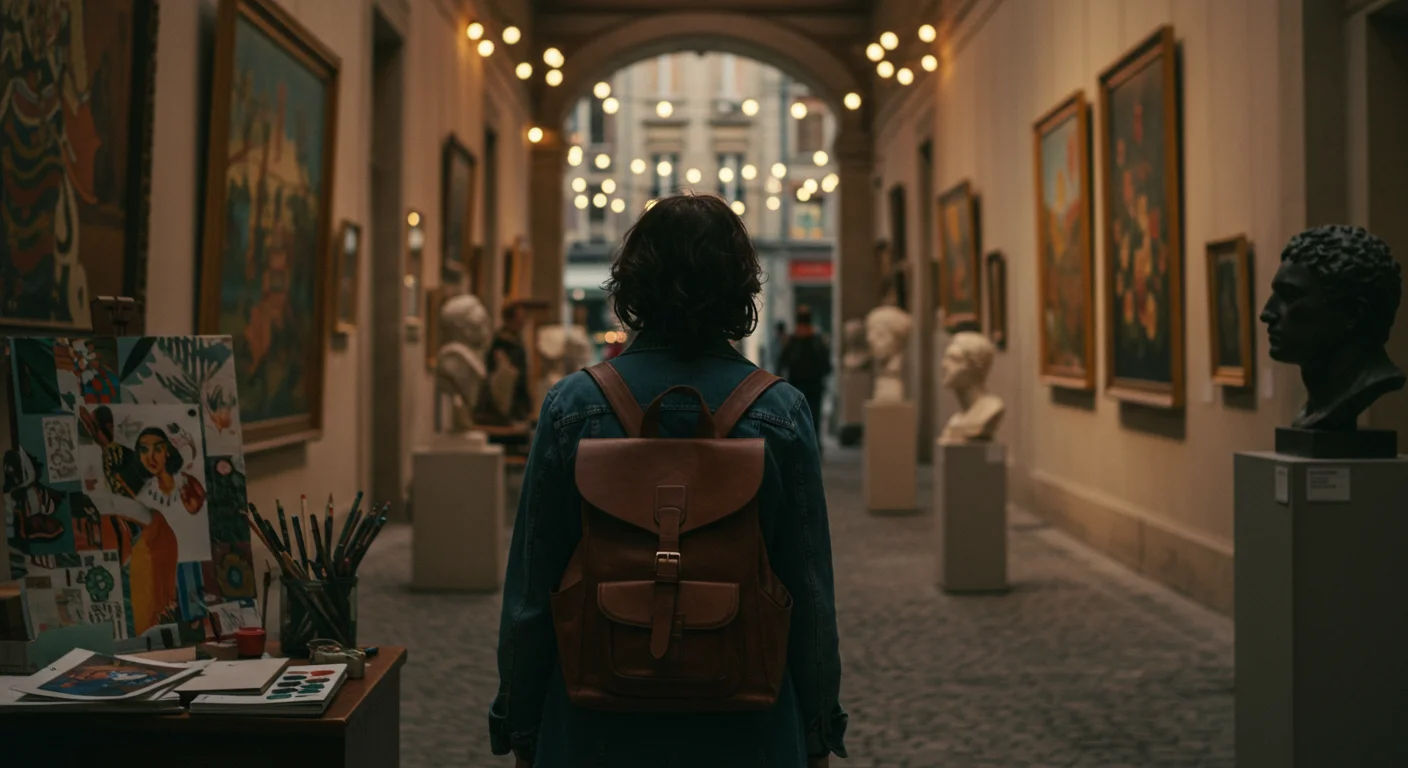Have you ever looked at a world-famous building or monument and felt a sense of wonder? Beyond their beautiful designs and the perfect pictures you see, many of these places hold incredible, often surprising, histories. These are the untold, or at least lesser-known, stories behind 5 iconic cultural landmarks that will make you see them in a whole new light. Get ready to discover hidden truths and unexpected twists that shaped these amazing global icons, making them even more fascinating!
Lady Liberty's Unplanned Makeover: The Statue of Liberty
Imagine the Statue of Liberty, that grand symbol of hope standing proudly in New York Harbor. You know her with her beautiful seafoam green color, right? But what if I told you she was originally a shiny, reddish-brown? When this colossal statue arrived from France in 1886, fresh from the workshop, she looked like a giant, gleaming copper penny. It is hard to picture, but it is true! Over many, many years, as she stood guard through all kinds of weather – rain, wind, and sea spray – her copper skin slowly began to change. Scientists call this process oxidation, which is like a slow chemical reaction with the air and water. This natural transformation was not something anyone planned, but it certainly was a slow-motion magic trick unfolding over decades. This color change has now become a huge part of her legend, a visual reminder that even the biggest symbols can evolve and adapt with time. It makes her even more special, do not you think?
Key Takeaways: Statue of Liberty
- The Statue of Liberty was initially a shiny, reddish-brown copper color upon its arrival in 1886.
- Its famous green color developed gradually over decades due to oxidation caused by exposure to the elements.
- This transformation was a natural, unplanned process, adding to the statue's unique legend as a symbol of hope.
As we continue to explore the stories behind 5 iconic cultural landmarks, let us move to a marvel of engineering that also holds tales of bravery and an unexpected color choice.
The Bridge That Saved Lives: The Golden Gate Bridge
San Francisco's Golden Gate Bridge is famous for its vibrant orange color and its stunning views, but did you know building it was incredibly dangerous? It was one of the riskiest construction projects of its time, and many workers faced terrifying heights and strong winds over the icy bay below. To keep the brave builders safe, engineers came up with a brilliant idea: they installed a giant safety net beneath the bridge. This was the very first time a net like this was used on such a big construction project, and it saved lives! Thanks to this net, 19 men survived falling off the bridge. They even earned a special nickname: the Halfway-to-Hell Club. Their stories are a gritty and heroic part of the bridge's history that most people never hear. So, next time you see that famous orange bridge, remember the courage and smart thinking that went into building it, and the workers who narrowly escaped danger. And speaking of orange, did you know that vibrant color was originally just the primer, a kind of base paint? Most bridges were black or silver back then, but the architect loved the bold orange so much, he convinced everyone to keep this color, now famously known as International Orange!
Key Takeaways: Golden Gate Bridge
- The bridge's construction was highly dangerous, leading engineers to install the first-of-its-kind giant safety net.
- This safety net saved 19 workers, who became known as the Halfway-to-Hell Club.
- The bridge's iconic International Orange color was originally just a primer, but was chosen to be the final color due to its bold appearance and visibility.
A Monument of Love, Mystery, and Deception: The Taj Mahal
The Taj Mahal in India is often called the world's most beautiful building, and it is certainly a breathtaking symbol of eternal love. It was built by Mughal Emperor Shah Jahan in memory of his beloved wife, Mumtaz Mahal, who sadly passed away during childbirth. It took over 20,000 workers more than two decades to build this stunning white marble mausoleum, which also includes beautiful gardens and a reflecting pool. But there are some truly amazing secrets about this architectural wonder that add to its grandeur. One popular story, though unproven, is that Shah Jahan originally planned to build a second Taj Mahal, exactly like the first, but made of black marble, for himself on the opposite side of the Yamuna River. This grand project was supposedly stopped when his own son, Aurangzeb, imprisoned him. Imagine two matching Taj Mahals! Another unbelievable tale comes from World War II. During the war, people were worried that the Taj Mahal might be bombed by enemy planes. So, what did they do? They created a clever illusion! Architects built a massive bamboo scaffold all around the building, making it appear like a giant pile of bamboo from above. This trick worked perfectly, and airborne bombers flew right past, not realizing what they were missing. These fascinating details truly enrich the stories behind 5 iconic cultural landmarks.
Key Takeaways: Taj Mahal
- The Taj Mahal was built by Emperor Shah Jahan as a monument of eternal love for his wife, Mumtaz Mahal.
- A popular legend suggests Shah Jahan intended to build a second, black marble Taj Mahal for himself.
- During World War II, a massive bamboo scaffold was built around the Taj Mahal to disguise it from aerial bombers.
The Great Wall's Human Cost and a Space Myth: The Great Wall of China
The Great Wall of China is an absolutely massive structure, stretching for thousands of miles across mountains and valleys. It is one of the most impressive things humans have ever built, and its main job was to protect China from invaders from the north. But the wall is not just about battles and protection; it is also about the countless people who worked on it, often under very harsh conditions. There is a sad and famous legend about a woman named Meng Jiangnu. Her husband was forced to work on the wall during the Qin Dynasty. She traveled a super long way to bring him warm clothes, only to find out he had died from exhaustion. Her heartbroken cries were so powerful, the story goes, that a section of the wall actually collapsed, revealing the bodies of the many laborers buried within it. This story reminds us of the immense human cost behind this incredible achievement. Another widely believed idea about the Great Wall is that it is the only man-made structure you can see from space. However, NASA, the space agency, has officially stated this is not true! While it is unbelievably long, it is also quite narrow and blends in with the natural landscape, making it very difficult to spot with the naked eye from orbit. So, it is still an amazing wonder, but maybe not quite visible from the moon!
Key Takeaways: Great Wall of China
- The Great Wall was primarily built over centuries to protect China from invaders.
- The tragic legend of Meng Jiangnu highlights the immense human sacrifice and hardship endured by the laborers.
- The popular belief that the Great Wall is visible from space with the naked eye is a myth, confirmed by NASA.
Our journey through the stories behind 5 iconic cultural landmarks continues with powerful tales of ancient spectacles and enduring spirits.
Gladiators, Ghosts, and Earthquakes: The Colosseum
Stepping into Rome's Colosseum is like traveling back in time to ancient Roman spectacles. This incredible amphitheater once hosted thrilling gladiator battles, wild animal hunts, and public executions. Can you imagine thousands of people cheering in those stands? But beneath the grand stone arches lies a chilling and dramatic past. Building it was a huge effort, taking about 60,000 enslaved people to complete this massive structure between 72 AD and 80 AD. Over nearly 400 years of games, it is believed that more than half a million people and a million animals lost their lives here. It is a powerful and sometimes haunting thought. The Colosseum has also bravely stood through two major earthquakes over the centuries, proving just how strong its design truly is, even today. Many visitors and historians speak of haunting stories, believing that the spirits of gladiators and early Christians still linger within the ruins. The underground chambers, known as the hypogeum, were where warriors and animals waited before their dramatic entrance into the arena. People often report hearing whispers, footsteps, and other eerie sounds when they visit. These ghostly echoes add a supernatural twist to the Colosseum's already legendary history, making it one of the most compelling of the stories behind 5 iconic cultural landmarks.
Key Takeaways: The Colosseum
- The Colosseum was built by around 60,000 enslaved people and hosted gladiatorial contests, animal hunts, and executions.
- It is estimated that over half a million people and a million animals perished during its nearly 400 years of use.
- The structure has survived multiple major earthquakes and is believed by some to be haunted by the spirits of gladiators and others who died there.
More Than Just Bricks and Mortar
From the Statue of Liberty's surprising color change to the Golden Gate Bridge's life-saving net, the Taj Mahal's hidden WWII trick, the human stories behind the Great Wall, and the ghostly whispers of the Colosseum, these iconic places are far more than just old buildings. They are living testaments to human ambition, love, tragedy, cleverness, resilience, and even a dash of enduring mystery. Each brick, stone, and curve holds a fascinating tale, waiting for you to discover it.
Exploring Deeper into History
Learning about the amazing pasts of these landmarks helps us appreciate them even more. It shows us that history is not just about dates and names; it is about real people, incredible ideas, and unexpected events that shaped the world we live in. The transformation of the Statue of Liberty reminds us that even grand symbols change over time. The Golden Gate Bridge's story is about bravery and innovation in the face of danger. The Taj Mahal whispers tales of undying love and wartime cleverness. The Great Wall speaks of immense human effort and enduring legends, while the Colosseum serves as a powerful reminder of ancient spectacles and enduring spirits. These deep dives into the stories behind 5 iconic cultural landmarks truly enhance our understanding and connection to our shared global heritage, inviting us to look beyond the surface of the world around us.
Ready to uncover more hidden histories and plan your next adventure to see these wonders yourself?



